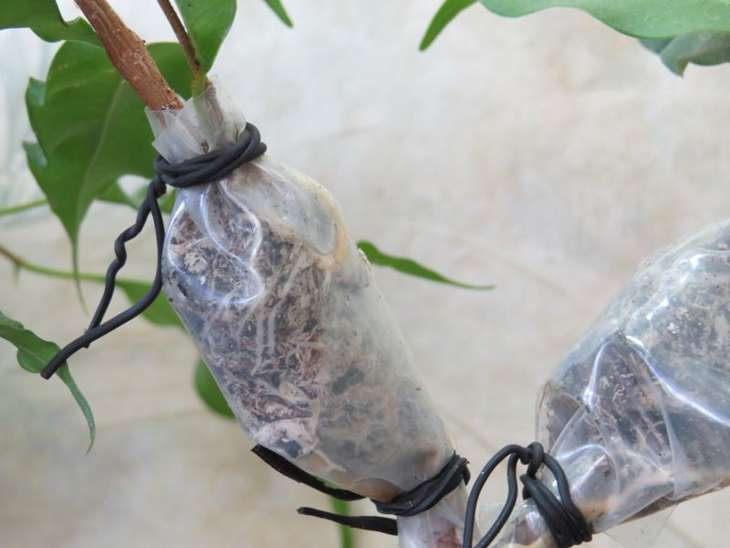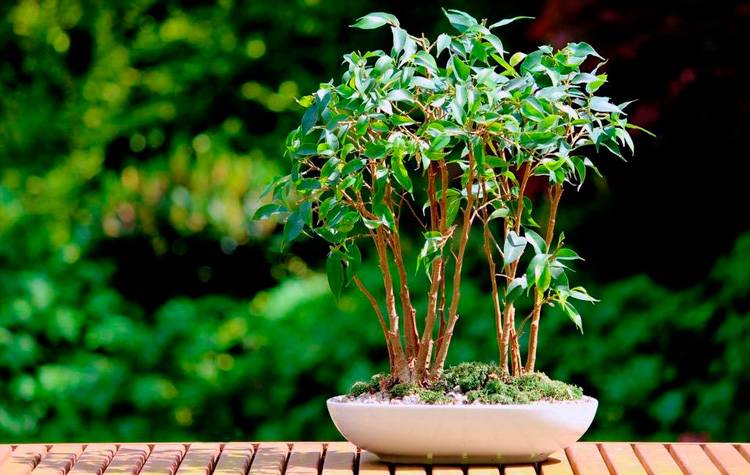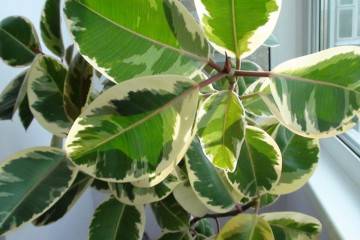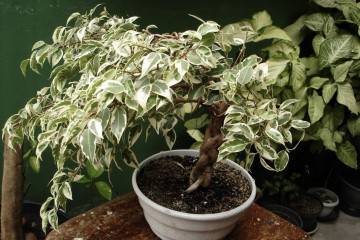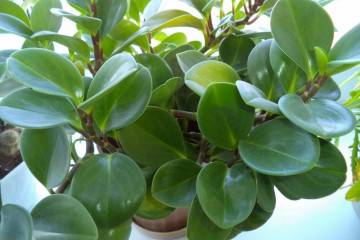Ficus - home care
Content:
Ficus is an ornamental deciduous houseplant, one of the most common and favorite among many flower growers. He is unpretentious and just take care of him. Ficus can be used to decorate any room, be it an apartment or an office.
What does the ficus look like, which family does it belong to
Ficuses attract attention with the beauty of their leaves and the shape of the plant itself. They come in different types: trees and shrubs, vines and banyan trees.
The most common varieties of indoor ficuses include:
- Ficus Benjamin. This is a indoor ficus plant, it grows in the form of a shrub with thin shoots. Its leaves are mostly dark green. This variety is one of the most popular in indoor floriculture. The height of such a flower can reach 2-3 meters with proper care. From its foliage, you can easily form both a lush bush and a neat thin tree.
- Bengal or rubbery ficus. This species is also called simply the rubber tree. The characteristics of this species are as follows: its leaves are large, oval and glossy; young leaves have a brownish tint, but over time they turn green. There are variegated varieties, which may have yellow and white spots on the leaves. The tree can reach 2 meters in height. This unpretentious plant has a decorative look. It grows straight up, and in order to make a branch, you need to cut off the top.
- Ficus is lyre-shaped. It is a broad-leaved large ficus with large and wavy green leaves. This plant looks best in spacious rooms.
- Ficus Microcarpa. Under natural conditions, this type of plant can grow up to 25 m in height. It grows due to the fact that it braids with the roots of neighboring plants. Most often, bonsai are formed from the ficus of this variety. Its roots can bend in the desired direction. The crown of such trees is compact, green.
- Ficus Karika. The more common name for this variety is fig or fig tree. It has large leaves, with fine villi or rough. At home, it can also bear fruit. In winter, the leaves fall off and the plant is dormant.
Healing properties
The presence of ficus in indoor flower collections has a beneficial effect on health. Its leaves purify the air by absorbing harmful chemical compounds in it and produce pure oxygen. In folk medicine, the juice of this plant is used. They also make tinctures from it with the help of which you can cure joint diseases that arise from metabolic disorders.
Briefly about the history of appearance
The homeland of ficus is considered to be the tropical and subtropical forests of Malaysia, Southeast Asia and the Philippines, as well as New Guinea. In the wild, the diameter of the largest specimens is about 5 meters, and they grow to a height of 40 meters.
Another famous homeland of ficuses is southern Indonesia and regions of India. There, this flower is considered sacred. Buddhists living in those places believe that Buddha was under this plant when he managed to enter nirvana.In Ceylon, it is believed that the first planted ficus tree, in 288 BC, personifies spirituality. All believers who come to the island tie bright ribbons to tree branches.
Ficus: home care
Caring for a plant at home is not difficult. Ficus is perfect for both experienced florists and beginners. This plant is unpretentious and thermophilic.
Temperature
As mentioned earlier, ficus is a plant that loves warmth. The favorable temperature for its proper growth and development in the summer period is 20-26 degrees, and in the winter - 15-20 degrees. Temperatures below 12-15 degrees can be detrimental to the plant.
It is very important that not only the environment is at a favorable temperature - the soil must also not be cold. If the soil is too cold, the ficus begins to shed its leaves.
Like many other plants, ficus must be protected from drafts, otherwise it will shed its leaves and stop developing normally.
Lighting
Direct sunlight is contraindicated for any type of ficus. It is best to place the flower in a bright part of the room, with good daylight. This is especially true for variegated ficuses. If the flower has dark green leaves, partial shade or diffused lighting will suit it.
Watering
The intensity of watering the ficus depends on the season. In the summer, watering should be abundant. But at the same time, between waterings, the soil should dry out a little, otherwise the root system will rot. In winter, the flower should be watered rarely and in small quantities.
Miniature varieties should be watered frequently, as their root system is closer to the top of the soil, and they absorb moisture only from the upper layers of the soil, which dries out rather quickly.
Spraying
For ficuses, sprays and showers are very useful. You can safely put the bush in the bathroom and water it from the shower with water at room temperature. The spray water should be soft, as hard water leaves white spots on the leaves.
In no case should a wet flower be placed in direct sunlight, as the leaves get burned and begin to turn black.
Humidity
This plant is unpretentious in terms of air humidity. But at the same time, if the air is too dry, it can lose leaves. It is better that the humidity is high. This is especially true of dwarf ficus varieties.
Priming
A suitable soil for growing ficuses is a soil with neutral acidity. There are ready-made special mixtures in stores.
You can also prepare the soil yourself.
- If you need to plant a young homemade ficus, then for the soil you should use leafy soil, sand and peat in a ratio of 1: 1: 1.
- When transplanting an adult plant, the soil should consist of: turf, leafy soil, peat and sand in a ratio of 2: 1: 2 or in equal parts.
In order to protect the root system from decay, you can add pieces of charcoal inside.
Top dressing
For the correct development of a flower, it must be fed with mineral or organic fertilizers in the spring and summer. This should be done every 10-15 days.
In the cold period, the plant should not be fertilized and fed, since it is dormant and does not require additional resources for development.

In order for the ficus to develop correctly, it must be periodically fertilized with mineral or organic preparations.
Features of care in winter, dormant period of ficus
How to care for a ficus when it is at rest? Many species of this plant can shed their leaves due to lack of light and heat. For example, a variety such as fig ficus sheds its leaves in winter and requires a lower temperature for keeping. Some simply slow down growth and development.
Watering the plant in winter is rarely necessary and in small quantities. Spraying during this period is not necessary. The soil should not freeze, otherwise the plant may die. During this period, it is better not to transplant the flower, since it does not have enough strength for engraftment and this can damage it.
When and how it blooms
In the wild, some species of ficus can be seen with small flowers of various shades, mostly light. It blooms regardless of the season, at any time of the year, since it is mostly always warm in its homeland.
Ficus home rarely blooms. Basically, this can be seen in large specialized greenhouses and botanical gardens, in which special climatic conditions are created, as close as possible to the conditions of the native area where these flowers grow.
Pruning
The peculiarity of the ficus is that it always grows upward; it cannot grow to the sides on its own. And therefore, to create a beautiful crown, you can do pruning. But this must be done with extreme caution.
If pruning is not done correctly, the plant may die. The most suitable time for pruning ficus is spring, when its greenery is forming. In autumn and winter, the plant feeds on nutrients accumulated in the shoots. And therefore, if you start a haircut at this time, you can cause irreparable damage.
A young plant should be pruned, since an adult is more difficult to tolerate this process. Carrying out the procedure, you need to take into account that new shoots grow from the apical or lateral buds. Removing the apical buds stimulates the lateral buds to grow and the plant grows wider.
How ficus reproduces
There are several ways to reproduce ficus, but only two options are applicable at home:
- rooting cuttings,
- air layering.
The rest of the breeding options for this flower at home are impossible.
Rooting cuttings
The most favorable time for ficus breeding is spring. In order for the cutting to take root successfully, there must be a temperature of 24-32 degrees. While a healthy plant is forming, you can cut off the apical cuttings. The shoot should be 10-15 cm long, with two or three leaves. You need to cut the stalk with a sharp knife at an angle. The lower leaf should be removed, and the upper ones should be shortened in half.
There are two ways to root cuttings:
- rooting in water,
- rooting in the ground.
For rooting in warm water, you need to add activated charcoal. Leaves should not get into the water. You need to put the cutting in water in a bright place with high humidity and at a temperature of about 25 degrees. Within 3-4 weeks, the ficus will give its first roots and it can be carefully planted in the prepared soil.
You can root the cutting by planting it in a loose substrate. It must be prepared from turf and leafy soil, peat and sand in a ratio of 1: 1: 2: 0.5. You can also use a mixture of peat and sand. Dip the dried stalk one knot into the soil and place this pot in a warm place. It needs to be covered with a jar or cut plastic bottle to create a greenhouse. The ground must be moist.
Air layering
Some varieties of ficus, such as Benjamin, can be propagated by air layering.
Description of this type of reproduction: a straight and strong shoot is needed, from which several leaves must be removed. Around the shoot, you need to make a circular incision and attach wet moss to this place. Then wrap it with cling film and secure it in knots on both sides. The moss must be constantly wet.
After 2-4 weeks, roots should appear in this place. When they break through the film, you need to plant the cutting in the ground.
Transfer
The most favorable time for transplanting ficus is spring. You need to replant a young plant every year. Mature plants should be transplanted every 2-3 years when necessary.
Why do you need to replant so often? The main reason for transplanting is an increase in the root system. Due to the fact that the roots grow and begin to crawl out of the drainage holes, moisture ceases to linger in the ground and the roots do not receive it in the required volume.
Possible growing problems and diseases
As with all indoor plants, ficuses can develop problems and diseases if the flower is not properly cared for. In order to cure a plant, you need to understand the causes of the disease and have an idea of how to care for a ficus at home.
Growing problems can be as follows:
- Drops the leaves. The ficus flower begins to throw off the leaves because there has been a sharp temperature drop. The leaves begin to curl up and fall off. It can also be affected by over-watering.
- The leaves turn pale. This happens when the plant lacks nutrients. In this case, you just need to transplant it.
- The tips of the leaves dry. This problem occurs when the soil dries out, as well as with sunburn. The leaves may begin to curl. Overfeeding with fertilizers can have a negative effect. The solution to these problems is obvious - it is necessary to exclude unfavorable factors.
- The lower leaves fall off. Sometimes the lower leaves can curl up and fall off. This is considered the norm. But it is important that the barrel is not completely exposed. We need proper watering and air humidity.
- Pests. If the air in the room where the ficus grows is very dry, pests such as mealybugs, scale insects, thrips and spider mites may appear on the flower. Most often, pest-infested leaves begin to curl. You can fight these pests with the help of special chemical solutions that are sold in stores.
Signs and superstitions
Each houseplant has different signs and superstitions associated with it. Regarding the ficus, there are also positive and negative signs, based on which, some people decide whether they should have this flower or not.
Positive signs include the fact that this plant strengthens the family and has a beneficial effect on the energy of the home. In Thailand, it is considered a sacred plant that brings good luck and happiness to the home. According to Chinese superstitions, it is believed that the ficus plant gives comfort and a pleasant atmosphere to a loved one, cleans the space of negativity.
But the Slavs are wary of this flower. They believe that he pushes the appearance of not very good feelings, such as anger, envy and a tendency to scandal.
Keeping such an unpretentious flower as ficus at home will not be a hassle. Also, this type of plant is popular in office decor. It does not require much maintenance and at the same time looks good in almost any interior.




